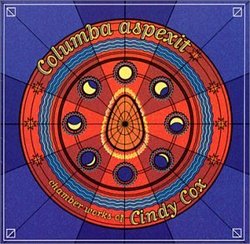| All Artists: Cindy Cox, Alexander Quartet, Peter Joseff, clarinet, Karen Bentley, violin, Earplay Ensemble, piano Karen Rosenak, electric drums, electric guitar, Mallet-Kat, keyboards, Paul Dresher Ensemble Title: Columba Aspexit: Chamber Music of Cindy Cox Members Wishing: 1 Total Copies: 0 Label: Composers Recordings Original Release Date: 2/1/2002 Release Date: 2/1/2002 Genre: Classical Styles: Chamber Music, Historical Periods, Classical (c.1770-1830) Number of Discs: 1 SwapaCD Credits: 1 UPC: 090438088626 |
Search - Cindy Cox, Alexander Quartet, Peter Joseff, clarinet, Karen Bentley, violin, Earplay Ensemble, piano Karen Rosenak :: Columba Aspexit: Chamber Music of Cindy Cox
 | Cindy Cox, Alexander Quartet, Peter Joseff, clarinet, Karen Bentley, violin, Earplay Ensemble, piano Karen Rosenak Columba Aspexit: Chamber Music of Cindy Cox Genre: Classical
These works by Cindy Cox take the listener on an experiential journey affecting the mind, spirit and body. The rite of passage begins with Geode (1996) for flute, clarinet, cello, percussion and piano, a piece of technical... more » |
Larger Image |
CD Details
Synopsis
Album Description
These works by Cindy Cox take the listener on an experiential journey affecting the mind, spirit and body. The rite of passage begins with Geode (1996) for flute, clarinet, cello, percussion and piano, a piece of technical and formal prowess that carries the listener first into the presence of an object of mind, a geode?something to capture the attention for the experience to follow. Like crystals forming around a dirty speck of earth, the shimmering glockenspiel, the high winds, and piano tremolos dance about the binding cello of the second movement. Indicating its bright features and high registers, the score is marked ?sparkling.? This movement, nearly twice as long as the outer two, provides the central fractal for the piece?s larger inflorescence, which is replicated in the work?s overall structure. Here, Cox balances the piece?s formality with a demonstration of her facility to modulate complex patterns of melody, pitch, timbre and resonance, through a loom work of breathtaking technique. As the cello?s shuttle gathers speed, the other instruments slow, their sparkling lyrici! sm caught in the warp and weft of a series of darker waves. As intimated, the outer movements frame the inner with sharp contrasts and share many formal parallels with each other. The first movement begins whimsically, full of irony, reminiscent of Klee or perhaps the more menacing Miro. The short, syncopated upward gestures are led by the bass clarinet. The cello joins in with pizzicato but ultimately leads the voices into a series of fractured and asymmetrical gestures that take all of them into the clarifying middle movement. The last movement is a palindrome of the first. Somehow the first movement?s gags are inverted as well. The jokes aren?t as funny having passed through the center of things. But they do shine. Ultimately, the journey is an inward descent that we might bring back that crystalline jewel through a recollection of our lost dream time. Finally, both the conscious and the unconscious minds are necessary and necessarily symbiotic in the attentive mind now called to attention. Columba aspexit (1995) for string quartet is based upon a chant by Hildegard von Bingen, a twelfth-century abbess, who transmuted the hallucinatory visions of her childhood into an art of gnosis, mysticism and spirituality. Her oracular painting, music and writing became so renowned for wisdom that popes and kings across medieval Europe sought her counsel. She dictated her visions and prophecies in a large volume called the Symphonia armonie celestium relationum (Symphony of the Celestial Harmonies). Among the collection?s fourteen chants, ?Columba aspexit? presents a fantastic and symbolic vision of Saint Maximinus as a celebrant at Mass. Roughly translated, the text opens:
Through the crosses
in the window,
the holy dove
gazed upon
a contemplative Maximinus,
anointing as with oils
his temples,
from whence spring
the jewel of purest heart
like the sun
burning its gloam. . . . ?from ?Columba aspexit? by Hildegard von Bingen The music?s ecstatic and transcendent character is achieved through the combinatory effects of its tremendous range, references to the major mode, and the special work of a personal elegy. Cox captures the unique melodic material of each section and releases its breadth, scope, imagery and inward spirituality. Apropos of Maximinus in his devotion, the first movement opens meditatively, slow, still, with a high-pitched violin in a disjunct theme (not based upon the chant), which is marked ?elegy? and dedicated to Elisabeth Terrell Cox-Hurst, the composer?s child who died at birth. Cox weaves this theme in and out, purifying it in the crucible of Hildegard?s hermetic chant. The pathos of the music rests in this deep collaboration, tragedy made numinous with understanding. The contrasting, active chant appears shortly after, and is elaborated and treated in canon (a kind of strict imitation between members of the quartet).
Through the crosses
in the window,
the holy dove
gazed upon
a contemplative Maximinus,
anointing as with oils
his temples,
from whence spring
the jewel of purest heart
like the sun
burning its gloam. . . . ?from ?Columba aspexit? by Hildegard von Bingen The music?s ecstatic and transcendent character is achieved through the combinatory effects of its tremendous range, references to the major mode, and the special work of a personal elegy. Cox captures the unique melodic material of each section and releases its breadth, scope, imagery and inward spirituality. Apropos of Maximinus in his devotion, the first movement opens meditatively, slow, still, with a high-pitched violin in a disjunct theme (not based upon the chant), which is marked ?elegy? and dedicated to Elisabeth Terrell Cox-Hurst, the composer?s child who died at birth. Cox weaves this theme in and out, purifying it in the crucible of Hildegard?s hermetic chant. The pathos of the music rests in this deep collaboration, tragedy made numinous with understanding. The contrasting, active chant appears shortly after, and is elaborated and treated in canon (a kind of strict imitation between members of the quartet).

 Track Listings (8) - Disc #1
Track Listings (8) - Disc #1